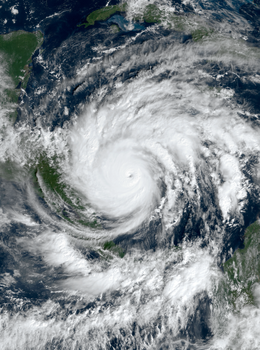Hurricane Iota - Simple English Wikipedia, the free encyclopedia
| Category 4 major hurricane (SSHWS/NWS) | |
 Hurricane Iota at peak intensity approaching Nicaragua on November 16. | |
| Formed | November 13, 2020 |
|---|---|
| Dissipated | November 18, 2020 |
| Highest winds | 1-minute sustained: 155 mph (250 km/h) |
| Lowest pressure | 917 mbar (hPa); 27.08 inHg |
| Fatalities | 67 direct, 17 indirect |
| Damage | $1.4 billion (2020 USD) |
| Areas affected | |
| Part of the 2020 Atlantic hurricane season | |
Hurricane Iota was a devastating late-season Category 4 Atlantic hurricane which caused severe damage to areas of Central America already devastated by Hurricane Eta just less than two weeks prior. The 31st and final tropical cyclone, 30th named storm, 14th hurricane, and record-tying seventh major hurricane of the record-breaking 2020 Atlantic hurricane season, Iota originated as a tropical wave that moved into the Eastern Caribbean on November 10. Over the next few days, the wave began to become better organized and by November 13, it developed into a tropical depression north of Colombia. The depression strengthened into Tropical Storm Iota six hours later. The storm was initially impacted by some wind shear, but a center relocation and relaxed shear allowed Iota to quickly strengthen into a hurricane on November 15, after which it underwent explosive intensification, peaking at Category 5 with wind speeds of 160 mph (257 km/h), operationally. However, the peak was adjusted down to a 155 mph (249 km/h) high-end Category 4 in post-season analysis. After weakening slightly, Iota made landfall in northeastern Nicaragua as a high-end Category 4 hurricane, becoming the strongest recorded hurricane to make landfall in Nicaragua in November. Iota then rapidly weakened as it moved inland, dissipating on November 18, the storm killed 61 people and 41 were reported missing during the storm
References[change | change source]


 French
French Deutsch
Deutsch